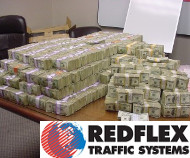Article from: www.thenewspaper.com/news/43/4397.asp
4/29/2014
Ousted Red-Light Camera Vendor Rakes In Windfall In Chicago, Illinois
Redflex leaves Chicago, Illinois under a cloud of scandal and with pockets full of cash.
 By The Expired Meter and DNAinfo Chicago
By The Expired Meter and DNAinfo Chicago
Even as Redflex Traffic Systems' scandal-plagued eleven-year tenure operating the nation's largest red-light camera system was ending, it was a particularly lucrative year for the company. The last Redflex cameras (at the intersection of Grand, Kostner and North) were turned off in February, but in the year before that, the company raked in $24 million, city records show, making this the second most profitable year in the company's Chicago history.
The money did not stop flowing after the February 2013 date on which the company was banned from bidding on new work with the city. Xerox State and Local Solutions now runs the city's red-light camera system.
"Redflex is out of the picture and [everything is] under the control of Xerox," Chicago Department of Transportation (CDOT) spokesman Pete Scales said Friday. "Their contract is over and we have no financial relationship with Redflex now."
Redflex was unceremoniously banned from bidding after the Chicago Tribune revealed an alleged bribery scandal that found the CDOT deputy commissioner overseeing the photo ticketing program accepted tickets to sporting events, luxury hotel accommodations, meals and other gifts from Redflex executives. Federal authorities are now investigating.
Redflex helped the city launch and then grow its red-light camera system from a handful of cameras and intersections to 384 cameras at about 190 locations citywide. The company has earned nearly $125 million since the program's inception in 2003. Redflex's contract was extended three times after it was originally set to expire in January 2013 to allow the city to select a new vendor and allow the cameras to be transitioned to the new company.
Only 2011 was more profitable for Redflex than last year. That year, the city had greatly expanded the scope of the program and payments to Redflex totaled more than $25 million.
Now that Xerox has complete control of the automated ticketing system, crews are converting the old hardware to their camera technology at the remaining 174 intersections with cameras. The city took 32 cameras at 16 intersections out of service as of January. The Redflex system utilized magnetic inductive wiring installed below the surface of the pavement to sense vehicles and trigger the cameras when a car entered the intersection after the signal turned red. Xerox uses a different setup designed to maximize revenue collection.
"The new Drivesafe red-light enforcement camera system being deployed in Chicago utilizes a small tracking radar for detecting vehicles," said Todd Jackson, director of technology for Xerox State and Local Solutions. "As a result it is less invasive, requires less infrastructure and the systems remain operable during street projects."
CDOT Deputy Director David Zavattero believes the Xerox technology is a step up from Redflex's system.
"With the magnetic induction loops, any disruption to the pavement -- potholes, cracks -- the loops get damaged," explains Zavattero. "The radar technology is mounted on a pole. It's non-intrusive and off the road which is preferable to us."
The new Xerox system allows the 352 cameras to be used by the police department, panning 360 degrees and streaming live video, bringing the total number of surveillance cameras accessible to police to 24,500, officials said. While police haven't used the cameras yet, police spokesman Adam Collins says his department is working with Xerox to incorporate them into the city's already extensive camera network.
"We welcome technology advancements that may have a potential public safety benefit, and we're working with other city agencies and their vendors to determine possible uses for this very new technology," said Collins.
The potential addition of hundreds of cameras to the city's police surveillance system raised concerns at the ACLU of Illinois, which last year called the 22,000 public and private cameras the police had access to a "frightening number." Ed Yohnka, a spokesman for ACLU Illinois, says Chicago needs to adopt more regulations like are on the books in Pittsburgh and Washington, DC, to protect the privacy rights of citizens.
"[This] is an exponential growth in the scope of surveillance cameras," Yohnka said. "If the red light cameras now can be used as part of a surveillance system, the same regulations or lack of regulations as far as privacy are now applied to the red light cameras."
Opponents of automated traffic camera enforcement such as the Wisconsin-based National Motorists Association are wary of Xerox as the program's replacement operator.
"Redflex has been embroiled in a multi-state bribery scandal so it's probably wise to part ways with them, but Xerox has had issues if its own," says the NMA's John Bowman. "In Baltimore, a city audit found that the Xerox-managed speed camera program had error rates in excess of 10 percent. That's roughly 70,000 faulty tickets a year."
CDOT Deputy Commissioner Larry McPhillips disagrees.
"We're satisfied with Xerox's performance so far," said McPhillips. "We still have a long way to go, but so far so good."
Detailed coverage of Chicago motoring issues can be found at The Expired Meter and at DNAinfo Chicago.
 By The Expired Meter and DNAinfo Chicago
By The Expired Meter and DNAinfo Chicago